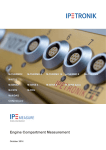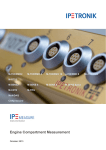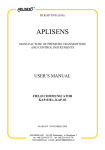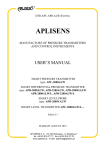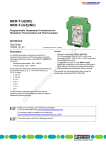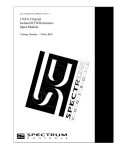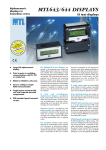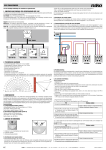Download - Aplisens SA
Transcript
DTR.LI-24(ENG) APLISENS MANUFACTURE OF PRESSURE TRANSMITTERS AND CONTROL INSTRUMENTS USER’S MANUAL RAIL-MOUNTED SMART TEMPERATURE TRANSMITTER TYPE LI-24 Edition F WARSAW AUGUST 2012 APLISENS S.A. 03-192 Warszawa, ul. Morelowa 7 tel. +48 22 814 07 77; fax +48 22 814 07 78 www.aplisens.pl, e-mail: [email protected] Symbols used Symbol i Description Warning to proceed strictly in accordance with the information contained in the documentation in order to ensure the safety and full functionality of the device. Information particularly useful during installation and operation of the device. Information particularly useful during installation and operation of a type Ex device. Information on disposal of used equipment BASIC REQUIREMENTS AND SAFE USE - The manufacturer will not be liable for damage resulting from incorrect installation, failure to maintain the device in a suitable technical condition, or use of the device other than for its intended purpose. - Installation should be carried out by qualified staff having the required authorizations to install electrical devices. The installer is responsible for performing the installation in accordance with these instructions and with the electromagnetic compatibility and safety regulations and standards applicable to the type of installation. - The device should be configured appropriately for the purpose for which it is to be used. Incorrect configuration may cause erroneous functioning, leading to damage to the device or an accident. - If a device is not functioning correctly, disconnect it and send it for repair to the manufacturer or to a firm authorized by the manufacturer. In order to minimize the risk of malfunction and associated risks to staff, the device is not to be installed or used in particularly unfavourable conditions, where the following dangers occur: - possibility of mechanical impacts, excessive shocks and vibration; - excessive temperature fluctuation, - condensation of water vapour, large dust, icing. Installation of intrinsic safety versions should be performed with particular care, in accordance with the regulations and standards applicable to that type of installation. The manufacturer reserves the right to make changes (not having a negative impact on the operational and metrological parameters of the products) without updating the contents of the technical manual. F 1 DTR. LI-24(ENG) CONTENTS 1. INTRODUCTION .............................................................................................................................. 2 2. APPLICATIONS AND MAIN FEATURES ........................................................................................ 2 3. CONSIGNMENT CONTENTS .......................................................................................................... 2 4. CONSTRUCTION AND MEASUREMENT PRINCIPLES ................................................................. 2 4.1. Electronic System – block diagram...................................................................................................... 3 5. USE OF THE LI-24 TRANSMITTERS IN DANGER ZONES ............................................................ 3 5.1. List of norms. ...................................................................................................................................... 3 5.2. LI-24 transmitters identification symbols. ............................................................................................. 3 5.3. Permitted intrinsic-safety parameters .................................................................................................. 4 5.3.1.Permitted sensors supply parameters (to 1, 2, 3, 4, 5 terminal sensors connection) ............... 4 5.3.2. Permitted input parameters (to <DC>, <DC> terminals current loop) ..................................... 4 5.4. Supply examples ................................................................................................................................ 4 5.4.1. - Power supply with linear characteristics ............................................................................. 4 5.4.2. – Power supply with the trapezoidal characteristics ............................................................. 4 5.4.3. - Power supply with the rectangular characteristics ............................................................. 5 5.5. Assembly recommendations ............................................................................................................... 5 5.5.1. General recommendations...................................................................................................... 5 5.5.2.Special conditions for safe use according to FTZU 08 and ATEX 0160X Certificates........... 5 5.5.3. LI-24 connecting at danger area. ............................................................................................ 6 6. TECHNICAL PARAMETERS. .......................................................................................................... 6 6.1. Electrical parameters: ......................................................................................................................... 6 6.2. Metrological parameters: ..................................................................................................................... 7 6.2.1. Input data, accuracy. ............................................................................................................... 7 6.3. Input with 2 sensors: .......................................................................................................................... 8 6.4. Normal usage conditions:.................................................................................................................... 9 7. SENSORS CONNECTION OPTIONS TO LI-24 TRANSMITTER. .................................................. 10 8. LI-24 TRANSMITTER CONFIGURATION ...................................................................................... 11 9. SAFETY CONDITIONS. ................................................................................................................. 11 10. STORAGE AND TRANSPORT. ..................................................................................................... 11 10.1. Storage. .......................................................................................................................................... 11 10.2. Transport. ....................................................................................................................................... 11 11. WARRANTY. ................................................................................................................................. 11 12. FIGURES ....................................................................................................................................... 12 Fig.1. LI-24 transmitter – block diagram. .................................................................................................... 3 Fig.2. The supplying principle with a source of linear characteristics........................................................... 4 Fig.3. The supplying principle with a source of trapezoidal characteristics. ................................................. 4 Fig.4 The supplying principle with a source of rectangular characteristics. .................................................. 5 Fig.5. Connecting transmitter circuit – sensors connecting according to p.7................................................ 6 Fig.6. Supply voltage in load resistance (Ro) function for LI-24 transmitter. Safe working area (grid) upper colour area............................................................................................................................. 6 Fig.7. Sensors connection options to LI-24 transmitter. ........................................................................... 10 Fig.8. Circuit LI-24 transmitter to configuration with PC computer and Hart-RS converter ........................ 11 Fig.9. Smart temperature transmitter type LI-24, dimensions, description. ................................................ 12 F 2 DTR. LI-24(ENG) SMART TEMPERATURE TRANSMITTERS TYPE LI-24 NORMAL VERSIONS Ex VERSIONS 1. INTRODUCTION This Manual is intended for users of smart temperature transmitters type LI-24 – in normal and intrinsicsafety versions. The data and information for the intrinsically safe LI-24 transmitter are given at point 5 „Use of the LI-24 transmitter in danger zones”. The data and parameters specified in other points of the Manual are common for both versions, and several differences relate to electrical supply have been taken into the text. 2. APPLICATIONS AND MAIN FEATURES i The rail-mounted smart temperature transmitters LI-24 are designed to resistance and voltage conversion in 4 – 20mA measuring signal with Hart communication. Transmitters have two measuring canals which carry through measuring difference, middle, middle with redundancy, minimum and maximum of temperature. Transmitters are factory compensated from ambient temperature effect and have compensation possibility of thermocouple cold lead ends with inside or offside sensors. The LI-24 transmitter features: a) b) c) d) e) f) g) Two-wire power supply (4…20mA current loop), Digital signal processing (filtration, linearization, compensation), Transmitter configuration possibility (with Hart Protocol) as sensor type, calibration, programming and range difference, user measuring profile enabling. Autodiagnostic system Ability to cooperate with resistive and thermocouple sensors, (see table 1 and 2) Ambient temperature effect compensation Input/output galvanic separation. 3. CONSIGNMENT CONTENTS Together with the transmitter are delivered : a) Product certificate, which is also as the warranty card, b) LI-24 Ex Declaration of Conformity, or LI-24 Declaration of Conformity - on request, c) LI-24 Ex Certificate copy– on request, d) User’s Manual signed „DTR.LI-24(ENG)”. Items b), c), d) are available at www.aplisens.pl 4. CONSTRUCTION AND MEASUREMENT PRINCIPLES All electronic components of the LI-24 temperature transmitter are mounted on the single printed-circuit board. Transmitter housing type: Transmitter dimensions: Index of the case protection: Diameter cable to the transmitter connecting: - rail-mounted, plastic PA - according to Fig.9 - IP20 - 2,5 mm2 F 3 DTR. LI-24(ENG) 4.1. Electronic System – block diagram. 1 2 SENSOR INPUT LOOPS ISOLATION SIGNAL STANDARDIZATION -compensation -linearisation -forming signal 4 ... 20mA and Hart 3 DC INTERFERENCE ELIMINATOR OUTPUT 4 ... 20mA DC 4 I 5 20mA SHIELD 4mA GND Tmin Tmax T Fig.1. LI-24 transmitter – block diagram. 5. USE OF THE LI-24 TRANSMITTERS IN DANGER ZONES 5.1. List of norms. The transmitters are made in according to the requirements of the following standards: EN 60079-0:2009, EN 60079-11:2012, EN 50303:2000, EN 60079-26:2007. The transmitters can be operated in explosion danger areas in accordance with the explosion-proof construction symbol: II 1G Ex ia IIC T4/T5 Ga I M1 Ex ia I Ma FTZU 08 ATEX 0160X 5.2. LI-24 transmitters identification symbols. Intrinsically safe transmitters must have a rating plate with the following data: a) The name of the producer; b) The LI-24 transmitter type; c) d) e) f) g) CE symbol and the Notified Body number; symbol; Explosion-proof construction index, certificate symbol as p.5.1; Input parameters values: Ui, Ii, Pi, Ci, Li and Uo, Io, Po, Co, Lo; Measurement range and output signal; Manufacture year and serial number; and additionally: h) front rating plate with sign leads; i) warning plate with inscription: „Don’t dry wipe”; j) leads signs. F 4 DTR. LI-24(ENG) 5.3. Permitted intrinsic-safety parameters 5.3.1.Permitted sensors supply parameters (to 1, 2, 3, 4, 5 terminal sensors connection) Uo = 6V, Io = 0.1A, Co = 10μF, Lo = 1.5mH, Po = 0.5W 5.3.2. Permitted input parameters (to <DC>, <DC> terminals current loop) The transmitters should be powered from power suppliers with the relevant intrinsic safety certificates, witch output parameters to danger zone not exceed the acceptable supply parameters to the transmitters as bellow: a) Power supply with linear characteristics Ui = 30V, Ii = 0.1A, Pi = 0.75W, Li = 1.1mH, Ci = 5nF Ta ≤ 700C and T5 b) Power supply with the trapezoidal characteristics Ui = 24V, Pi = 0.7W, Ii = 0.05A, Li = 1.1mH, Ci = 5nF Ta ≤ 750C and T5 c) Power supply with the rectangular characteristics Ui = 24V, Pi = 0.6W, Ii = 0.025A, Li = 1.1mH, Ci = 5nF Ui = 24V, Pi = 1.2W, Ii = 0.05A, Li = 1.1mH, Ci = 5nF Ta ≤ 750C and T5 Ta ≤ 750C and T4 5.4. Supply examples i Used bellow signs Uo and Io accord to transmitter supply and are other than above mentioned (p. 5.3.1) 5.4.1. - Power supply with linear characteristics Power supply with a “linear” characteristic may be a typical barrier with parameters: Uo = 30V Io = 0.1A Ii Rw = 300 Rw UQ ID Uo Io Uo Io I zasilania o charakterystyce liniowej (Radwanice) Fig.2. TheZasada supplying principle with a source of linear characteristics 5.4.2. – Power supply with the trapezoidal characteristics for Ta 75C and T5 Uo = 24V Io = 0.05A Po = 0.6W UQ = 48V Ii Io Rw ID UQ Ui Uo UQ Uo Io Fig.3. The supplying principle with a source of trapezoidal characteristics. If Uo < UQ 2 parameters UQ, Ii, Pi are interrelated as follows: UQ = 4Po Io Rw = 4Po Io² Po = Uo • (UQ – Uo) R I F 5 DTR. LI-24(ENG) 5.4.3. - Power supply with the rectangular characteristics Ta 75C and T4 Ui = 24V Ii = 0,05A Pi = 1,20W Power supply with the rectangular characteristics means that the intrinsically safe supplier voltage does not change until the current limiter is activated. Io U Uo Uo Io I Fig. 4 The supplying principle with a source of rectangular characteristics. The power supplier with rectangular characteristics usually has the “ib” protection level. Each transmitter powered from such supplier is also the intrinsically safe device with “ib” protection level. 5.5. Assembly recommendations 5.5.1. General recommendations The LI-24 Transmitter connection should be made in accordance with fig. 5. The transmitter should be assembled at horizontal rail in the connecting boxes. Should be kept min distance 50mm between the terminals and the conducted circuit accessories galvanic separated. If the distances aren’t kept is necessary to apply the isolated or grounded conducted partition. The next electrical installations in the box should be assembled in the way encroaching of separation rules between intrinsically safe circuits and non intrinsically safe circuits. At the boxes and at the cases should be put the signs informing about assembled devices and about leading out places. Essential for the proper transmitter working with the outside part measuring system is connecting of transmitter with regard to the intrinsically rules (EN 600079-25) as well as the maintenance of entrance / exit parameters. It is not allowed to repair or otherwise interfere with the transmitter’s electrical circuits in any way. Assessment of damage and any necessary repairs may be carried out only by the manufacturer or by a firm authorized by the manufacturer. 5.5.2.Special conditions for safe use according to FTZU 08 and ATEX 0160X Certificates. When installed as category G equipment, the unit must be mounted inside of enclosure or under the cover complying with requirements of EN 600079-0:2009, clause 7.4.2 or 8.1.2 when these are made of plastic and light alloy respectively. When installed as category M1 or M2 equipment the unit must be mounted inside of enclosure which affords it a degree of protection of at least IP 54. Non metallic enclosures must comply with requirements of EN 60079-0:2009, clause 7.4.2. Light alloy enclosures are not allowed. Hazardous area F Safe area 6 DTR. LI-24(ENG) 5.5.3. LI-24 connecting at danger area. Hazardous area Safe area In hazardous areas, connections to the control terminals must be made using only instruments which are permitted to be used in such areas Milliammeter + mA _ Ro www.aplisens.pl LI-24 RTD, Thermocouple Electrical isolation F1 F2 F3 PF RE F4 PV F4 ABC DEF GHI @%& JKL MNO PQR +/ STU VWX YZ# . 7 4 1 8 5 2 9 6 3 a Ex power supply see p.5. 0 * Aplisens KAP-03Ex Communicator Sensors connection as p.7 If the resistance seen from the transmitter to the line is Ro > 250 is possible communication with the transmitter via a communicator connection to "DC " and "DC " terminals as shown on figure. (Ro = line resistance + load). If Ro < 250, there will be no communication and resistance in the measuring line should be increased to at least 250, as shown on figure. Communicator has to have certificate for connection to a signal line leading at the danger zone. Example Aplisens KAP-03Ex. If such is missing, the transmitter should be configured and calibrated at a safe zone and communicator can’t be connected to line entered to danger zone. Fig.5. Connecting transmitter circuit – sensors connecting according to p.7. 6. TECHNICAL PARAMETERS. 6.1. Electrical parameters: - Input signal thermocouple, resistance sensor, resistance, voltage, with accordance to tables 1 and 2 4...20mA + Bell202/Hart Rev.5.1 14 – 50VDC - Output signal - Power supply - Power supply for intrinsic-safe versions - in accordance with p.5. Usup[V]-14V 0,023A Ro = - Resistance for communication (Hart) 250÷1100 Vmin [V] - Load resistance 45 40 35 30 25 20 15 10 0 Umax. Ex 250 500 750 1000 Ro[] Fig.6. Supply voltage in load resistance (Ro) function for LI-24 transmitter. Safe working area (grid) upper colour area. F 7 DTR. LI-24(ENG) List of current alarms Alarm Type Value of Alarm Current Alarm Type Value of Alarm Current NORMAL LOW 3,75 mA NORMAL HIGH 21,6 mA CUSTOM (value of alarm current is defined by user) Value of alarm current in interval 3,6 mA 23 mA NAMUR LOW 3,6 mA NAMUR HIGH 21,0 mA LAST VALUE (transmitter does not update analog exit) Alarm current value is equal to the current value in the time preceding the event which giving an alarm. Galvanic separation user processing profile - electrical strength: - resistance: 1500V 500MΩ rms in 1 min 6.2. Metrological parameters: - sensors kinds , ranges and accuracy - user processing profile - resolution A/C conversion - input impedance, thermocouples or voltage inputs - supply voltage changes error - temperature error - temperature compensation - output signal setting time - additional voltage damping - time of single conversion see table 1. to 50 measuring points 24 bit >10MΩ ± 0,002%/V see table 1 50 points at temperature working range segmental with linear approximation between points 0.3 – 1.2s 0 – 30s 200 ÷ 1000ms 6.2.1. Input data, accuracy. Table 1. Sensor types, ranges, accuracy. Sensor RTD 2,3,4-wires connection Input – RTD Thermoresistance sensors Sensor current Max. wires resistance Sensor type Standard C 3 -200÷850 -200÷850 -200÷850 -200÷850 -200÷850 -200÷266 Min. measuring range K 4 10 10 10 10 10 10 -200÷650 10 -60 ÷ 180 -50 ÷ 180 -200÷630 -200÷630 -200÷630 10 10 10 10 10 Normal range 0 1 Pt10 (α=0.003850) Pt50 (α=0.003850) Pt100 (α=0.003850) Pt200 (α=0.003850) Pt500 (α=0.003850) Pt1000 (α=0.003850) Pt 98 (α=0.003923) Ni100 (W100=1.617) Cu100 (W100=1.426) Pt10 (α=0.003916) Pt50 (α=0.003916) Pt100 (α=0.003916) 2 IEC751, DIN43760, JISC 1604-97, BS 1904 SAMA RC-4-1966 PN-83/M53952 JIS C160481 2,3,4-wires connection ~420uA 25Ω Accuracy Temperature Analogue output error error ∆p ∆tp K K/K % 5 6 7 ±0.8 ±0.035 ±0.2 ±0.0070 ±0.07 ±0.0035 ±0.2 ±0.0020 Analog output ±0.05 ±0.0007 error: 0,05% ±0.03 ±0.0003 FSO(Full Scale Output) in all ±0.07 ±0.0035 temperature ±0.07 ±0.0030 working range ±0.07 ±0.0030 ±0.8 ±0.035 ±0.2 ±0.0070 ±0.07 ±0.0035 F Pt10 (W100=1.3910) Pt50 (W100=1.3910) Pt100 (W100=1.3910) Pt500 (W100=1.3910) GOST 6651Cu50 (W100=1.426) 94 Cu100 (W100=1.426) Cu50 (W100=1.428) Cu100 (W100=1.428) Ni100 (W100=1.617) 8 -200÷1100 -200÷1100 -200÷1100 -200÷1100 -50 ÷ 200 -50 ÷ 200 -185 ÷ 200 -185 ÷ 200 -60 ÷ 180 DTR. LI-24(ENG) 10 10 10 10 10 10 10 10 10 ±0.8 ±0.2 ±0.07 ±0.05 ±0.2 ±0.07 ±0.2 ±0.07 ±0.07 ±0.035 ±0.0070 ±0.0035 ±0.00070 ±0.0070 ±0.0030 ±0.0070 ±0.0030 ±0.0030 Analog output error: 0,05% FSO(Full Scale Output) in all temperature working range Resistance (resistor, potentiometer) Zakres pomiarowy 1 Zakres pomiarowy 2 1 Ω 0…400 0…2000 3 2 Ω 10 10 4 mΩ ±30 ±120 5 mΩ ±2 ±2 6 As above 7 6.3. Input with 2 sensors: - Difference - Middle - Middle with redundancy outputs value: Ch1 – Ch2 or Ch2 – Ch1 outputs value; 0.5 * (Ch1 + Ch2) outputs value: 0.5 * (Ch1 + Ch2) or Ch2 or Ch1 when this second is damaged - Minimum - Maximum outputs value: min (Ch1, Ch2) outputs value: max (Ch1, Ch2) Table 2. Sensor types, ranges, accuracy. Thermocouples Input – Thermocouple Input impedance Max. wires resistance Cold ends compensation Sensor type Standard Normal range 0 1 C K K K/K % 2 3 4 5 6 7 250 ÷ 1820 10 ±0.55 <±0.001 IEC584, -200 ÷ 1000 10 ±0.15 <±0.001 NIST MN175, -210 ÷ 1200 DIN43710, -200 ÷ 1372 BS4937, ANSI MC96.1, -200 ÷ 1300 10 ±0.20 <±0.001 10 ±0.30 <±0.001 B (Pt30Rh-Pt6Rh) E (Ni10Cr-Cu45Ni) J (Fe-Cu45Ni) K (Ni10Cr-Ni5) N(Ni14CrSi-NISi) >10MΩ 500Ω (wires + thermocouple) internal sensor, external sensor Pt100, state worth Accuracy Temperature Min. Analogue output error measurin error ∆p ∆tp g range 10 ±0.25 <±0.001 R(Pt13Rh-Pt) JIS C1602, -20 ÷ 1768.1 10 ±0.35 <±0.001 S(Pt10Rh-Pt) NF C42-321 -30 ÷ 1768.1 10 ±0.40 <±0.001 -200 ÷ 400 10 ±0.15 <±0.001 GOST P 8.585-200 ÷ 800 2001 10 ±0.20 <±0.001 ±[0.35+0.007 (T-273)] <±0.009 T(Cu-Cu45Ni) TC Typ L, Internal sensor CJC -25 ÷ 75 Analog output error: 0,05% FSO(Full Scale Output) in all temperature working range F 9 DTR. LI-24(ENG) Voltage mV mV µV -10 … 100 10 ±6 <±0.001 -100 … 1000 10 ±50 <±0.001 3 4 5 6 Measuring range 1 Measuring range 2 1 2 As above 7 ∆G – limiting error [K] or [%] calculated according to data (Tables 1 and 2). i [K] ∆G [K] = ∆p [K] + ∆tp [K] ∆G [%] = ∆p [K] * 100% TN [K] * TO [K] + TN [K] * 0.05 [%] 100 [%] + ∆tp [K] * TO [K] * 100% TN [K] [K] ; + 0.05% ; TN [K] - the setting range width of the measured temperature; algebraical difference between upper and bottom limit of setting range. TO [K] - ambient temperature range width of the transducer; the algebraical difference between upper and bottom ambient temperature (accepted as extreme temperatures of work). 6.4. Normal usage conditions: - Ambient temperature - Relative humidity - Constant and variable magnetic field - Atmosphere components -25 … 750C to 80% 0 … 400A/m no aggressive components F 10 DTR. LI-24(ENG) 7. SENSORS CONNECTION OPTIONS TO LI-24 TRANSMITTER. Fig.7. Sensors connection options to LI-24 transmitter. F 11 DTR. LI-24(ENG) 8. LI-24 TRANSMITTER CONFIGURATION To transmitter configuration is necessary: i - DC Voltage supplier for example: 24VDC - KAP 03 or KAP 03Ex communicator or - Hart-RS converter and PC computer with Windows XP / Vista / 7 system and a "Raport 2" or "LI24 Configurator” configuration program. Connection as Fig.8 BELL 202 RS 232 Milliammeter + Power supply/ mA _ Ro www.aplisens.pl LI-24 RTD, Thermocouple Electrical isolation F1 F2 F3 PF RE F4 DEF GHI @%& JKL MNO PQR +/ STU VWX YZ# . 4 1 8 5 2 9 6 3 "Raport 2" or F4 PV ABC 7 current loop 0 * Communicator KAP-03Ex Sensors connection as p.7 If the resistance seen from the transmitter to the line is Ro > 250 is possible communication with the transmitter via a communicator connection to "DC " and "DC " terminals as shown on figure. (Ro = line resistance + load). If Ro < 250, there will be no communication and resistance in the measuring line should be increased to at least 250, as shown on figure. Fig.8. Circuit LI-24 transmitter to configuration with PC computer and Hart-RS converter After configuration it is important to protect the transducers using command HART [247]. During work transmitter should be safe prior to entries. This prevents accidental or intentional changes configurational data. The protection function is accessible in KAP03 communicator, “Raport 2” or “LI-24 Configurator” software, as well as, in applying DD or DMT programs libraries. 9. SAFETY CONDITIONS. All the operations (inspection, verification) can be performed only if the contents of the Manual have been carefully read and understood. Before making any connections it` is absolutely necessary to disconnect the power supply and input signal. 10. STORAGE AND TRANSPORT. 10.1. Storage. The transmitter should be stored in original packaging in a closed place, free from any aggressive or corrosion-causing agents, in the temperature from 0°C to 70°C and relative humidity below 80%, protected against vibrations and shock. 10.2. Transport. The transmitters should be transported in individual packaging and/or bulk packaging by covered means of transportation. The packaging should be secured to stop them from moving and protected from direct impact of weather conditions. 11. WARRANTY. The producer gives a warranty on terms and conditions determined in the “Product certificate”, which is also as the warranty card. F 12 DTR. LI-24(ENG) 12. FIGURES output side analog/Hart input side (sensors connection) 03-192 WARSZAWA ul. Morelowa 7 tel. 022 814 07 77 fax 022 814 07 78 www.aplisens.pl 1453 Input signal: U, R, Pt 10, Pt 50, Pt 100, Pt 200, Pt 500, Pt 1000, Pt 98, Ni 100, Cu 100, B, E, J, K, N, R, S, T Output signal: 4...20mA + HART rev 5.1 Power supply: max 30V DC Abient temperature: . . . 75C (. . . 70C for power supply with linear char.) Serial number: ....... Year of manufacture: . . . . . . . II 1G Ex ia IIC T4/T5 I M1 Ex ia I FTZÚ 08ATEX... OSTRZEŻENIE ! NIE PRZECIERAĆ NA SUCHO WARNING ! only for Ex version www.aplisens.pl LI-24 27,5 DON'T DRY WIPE RTD, Thermocouple Electrical isolation 95 TYPE LI-24 80 Fig.9. Smart temperature transmitter type LI-24, dimensions, description.
















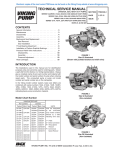
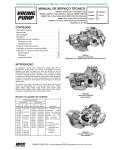
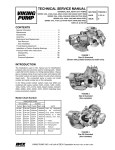

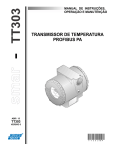
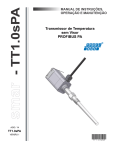
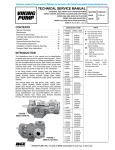
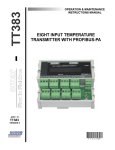
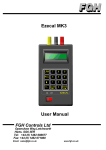
![[17] User`s Manual ver. 2.0.2](http://vs1.manualzilla.com/store/data/005765389_1-e376d351ef2708f30fcfdc5f98b9ba18-150x150.png)
